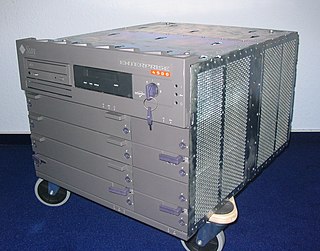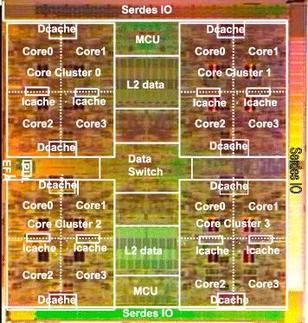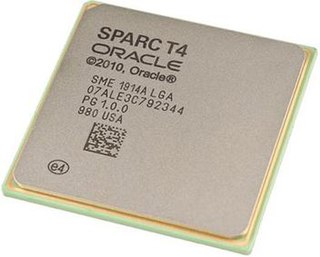Related Research Articles

Sun Microsystems, Inc. was an American technology company that sold computers, computer components, software, and information technology services and created the Java programming language, the Solaris operating system, ZFS, the Network File System (NFS), and SPARC microprocessors. Sun contributed significantly to the evolution of several key computing technologies, among them Unix, RISC processors, thin client computing, and virtualized computing. Notable Sun acquisitions include Cray Business Systems Division, Storagetek, and Innotek GmbH, creators of VirtualBox. Sun was founded on February 24, 1982. At its height, the Sun headquarters were in Santa Clara, California, on the former west campus of the Agnews Developmental Center.

SPARC is a reduced instruction set computer (RISC) instruction set architecture originally developed by Sun Microsystems. Its design was strongly influenced by the experimental Berkeley RISC system developed in the early 1980s. First developed in 1986 and released in 1987, SPARC was one of the most successful early commercial RISC systems, and its success led to the introduction of similar RISC designs from many vendors through the 1980s and 1990s.

Solaris is a proprietary Unix operating system originally developed by Sun Microsystems. After the Sun acquisition by Oracle in 2010, it was renamed Oracle Solaris.

Sun Enterprise is a range of UNIX server computers produced by Sun Microsystems from 1996 to 2001. The line was launched as the Sun Ultra Enterprise series; the Ultra prefix was dropped around 1998. These systems are based on the 64-bit UltraSPARC microprocessor architecture and related to the contemporary Ultra series of computer workstations. Like the Ultra series, they run Solaris. Various models, from single-processor entry-level servers to large high-end multiprocessor servers were produced. The Enterprise brand was phased out in favor of the Sun Fire model line from 2001 onwards.

Tadpole Computer was a manufacturer of rugged, military specification, UNIX workstations, thin client laptops and lightweight servers.

The Sun Ultra series is a discontinued line of workstation and server computers developed and sold by Sun Microsystems, comprising two distinct generations. The original line was introduced in 1995 and discontinued in 2001. This generation was partially replaced by the Sun Blade in 2000 and that line was in itself replaced by the Sun Java Workstation—an AMD Opteron system—in 2004. In sync with the transition to x86-64-architecture processors, in 2005 the Ultra brand was later revived with the launch of the Ultra 20 and Ultra 40, albeit to some confusion, since they were no longer based on UltraSPARC processors.

Sun Fire is a series of server computers introduced in 2001 by Sun Microsystems. The Sun Fire branding coincided with the introduction of the UltraSPARC III processor, superseding the UltraSPARC II-based Sun Enterprise series. In 2003, Sun broadened the Sun Fire brand, introducing Sun Fire servers using the Intel Xeon processor. In 2004, these early Intel Xeon models were superseded by models powered by AMD Opteron processors. Also in 2004, Sun introduced Sun Fire servers powered by the UltraSPARC IV dual-core processor. In 2007, Sun again introduced Intel Xeon Sun Fire servers, while continuing to offer the AMD Opteron versions as well.
Sun Microsystems' UltraSPARC T1 microprocessor, known until its 14 November 2005 announcement by its development codename "Niagara", is a multithreading, multicore CPU. Designed to lower the energy consumption of server computers, the CPU typically uses 72 W of power at 1.4 GHz.
OpenSPARC is an open-source hardware project, started in December 2005, for CPUs implementing the SPARC instruction architecture. The initial contribution to the project was Sun Microsystems' register-transfer level (RTL) Verilog code for a full 64-bit, 32-thread microprocessor, the UltraSPARC T1 processor. On March 21, 2006, Sun released the source code to the T1 IP core under the GNU General Public License v2. The full OpenSPARC T1 system consists of 8 cores, each one capable of executing four threads concurrently, for a total of 32 threads. Each core executes instruction in order and its logic is split among 6 pipeline stages.
The Sun Fire 15K was an enterprise-class server computer from Sun Microsystems based on the SPARC V9 processor architecture. It was announced on September 25, 2001, in New York City, superseding the Sun Enterprise 10000. General availability was in January 2002; the last to be shipped was in May 2005.

Rock was a multithreading, multicore, SPARC microprocessor under development at Sun Microsystems. Canceled in 2010, it was a separate project from the SPARC T-Series (CoolThreads/Niagara) family of processors.
The UltraSPARC IVJaguar and follow-up UltraSPARC IV+Panther are microprocessors designed by Sun Microsystems and manufactured by Texas Instruments. They are the fourth generation of UltraSPARC microprocessors, and implement the 64-bit SPARC V9 instruction set architecture (ISA). The UltraSPARC IV was originally to be succeeded by the UltraSPARC V Millennium, which was canceled after the announcement of the Niagara, now UltraSPARC T1 microprocessor in early 2004. It was instead succeeded by the Fujitsu-designed SPARC64 VI.

Sun Microsystems' UltraSPARC T2 microprocessor is a multithreading, multi-core CPU. It is a member of the SPARC family, and the successor to the UltraSPARC T1. The chip is sometimes referred to by its codename, Niagara 2. Sun started selling servers with the T2 processor in October 2007.
Logical Domains is the server virtualization and partitioning technology for SPARC V9 processors. It was first released by Sun Microsystems in April 2007. After the Oracle acquisition of Sun in January 2010, the product has been re-branded as Oracle VM Server for SPARC from version 2.0 onwards.
The SPARC Enterprise series is a range of UNIX server computers based on the SPARC V9 architecture. It was co-developed by Sun Microsystems and Fujitsu, announced on June 1, 2004, and introduced in 2007. They were marketed and sold by Sun Microsystems, Fujitsu, and Fujitsu Siemens Computers under the common brand of "SPARC Enterprise", superseding Sun's Sun Fire and Fujitsu's PRIMEPOWER server product lines. Codename is APL.
Afara Websystems Inc. was a Sunnyvale, California, USA server company whose goal was to build servers surrounding a custom high-throughput CPU architecture, "developing IP traffic management systems that will bring quality-of-service to the next generation of IP access infrastructure." The word "Afara" means "bridge" in the West African Yoruba language.

The UltraSPARC II, code-named "Blackbird", is a microprocessor implementation of the SPARC V9 instruction set architecture (ISA) developed by Sun Microsystems. Marc Tremblay was the chief architect. Introduced in 1997, it was further development of the UltraSPARC operating at higher clock frequencies of 250 MHz, eventually reaching 650 MHz.
The SPARC T3 microprocessor is a multithreading, multi-core CPU produced by Oracle Corporation. Officially launched on 20 September 2010, it is a member of the SPARC family, and the successor to the UltraSPARC T2.

The SPARC T4 is a SPARC multicore microprocessor introduced in 2011 by Oracle Corporation. The processor is designed to offer high multithreaded performance, as well as high single threaded performance from the same chip. The chip is the 4th generation processor in the T-Series family. Sun Microsystems brought the first T-Series processor to market in 2005.
The SPARC T-series family of RISC processors and server computers, based on the SPARC V9 architecture, was originally developed by Sun Microsystems, and later by Oracle Corporation after its acquisition of Sun. Its distinguishing feature from earlier SPARC iterations is the introduction of chip multithreading (CMT) technology, a multithreading, multicore design intended to drive greater processor utilization at lower power consumption.
References
- 1 2 3 "Sun Fire T2000 Server". Sun Microsystems. Retrieved 2011-01-27.[ dead link ]
- ↑ "Sun Introduces T1000/T2000". AnandTech. Retrieved 2011-01-27.
- ↑ "Sun T2000 Server". Acclinet. Retrieved 2011-01-27.
- ↑ "Sun charges Sun Fire T2000 with UltraSparc". InfoWorld. 6 December 2005. Retrieved 2011-01-27.